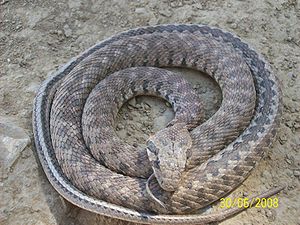Ravergier's Wrath Snake
| Ravergier's Wrath Snake | ||||||||||||
|---|---|---|---|---|---|---|---|---|---|---|---|---|

Ravergier's Wrath Snake ( Hemorrhois ravergieri ) |
||||||||||||
| Systematics | ||||||||||||
|
||||||||||||
| Scientific name | ||||||||||||
| Hemorrhois ravergieri | ||||||||||||
| ( Ménétries , 1832) |
Ravergier's angry snake ( Hemorrhois ravergieri , syn .: Coluber ravergieri ), also Ravergieri's angry snake or colorful angry snake , belongs to the genus Hemorrhois within the family of snakes (Colubridae) . The species was first described scientifically in 1832 by Édouard Ménétries . There are no known subspecies.
features
Ravergier's wrath snake usually reaches a body length of a total of just over 100 cm, animals with a length of around 150 cm have also been found in Western Asia. In general, the species looks strong and somewhat stocky. The head is of medium size and does not stand out very much from the rest of the body. The basic color of the body is gray to gray-brown or grayish olive. Darker, partly light-lined spots stretch over the back, which initially merge into a wavy band towards the rear and then into a straight line on the tail. A series of darker spots can also be seen on the flanks, which flow together in a line on the tail. There is a roundish spot under each eye, two V-shaped bands on the back of the head and one band each from the corner of the mouth to the eye. The belly side is gray-white in color and shows darker speckles, in addition there are spots that melt together in a band towards the anal shield. If you take a closer look at the scaling of Ravergier's Wrath Snake, it shows 21 rows of dorsal scales, large over-eye shields ( supraocularia ), a rein shield ( loreale ), two fore-eye shields ( praeocularia ), two rear-eye shields ( postocularia ) and an under-eye shield ( suboculars ) on the front edge of the eye ) on.
Snake venom
Ravergier's Wrath Snake is not assigned to either the false snakes or the venomous snakes. However, it has Duvernoy's glands that produce toxic secretions. In the event of a bite, this enters the wound via the saliva. The poisoning (intoxication) is usually only accompanied by severe local symptoms, such as swelling and pain in the bitten limb and discoloration. Symptoms can last for a few days.
Way of life
Ravergier's Wrath Snake is a snake that is active during the day and can be seen sunbathing in the morning and afternoon. She stays near hiding places that can be represented by piles of stones and bushes. She is a good climber and can move extremely quickly even on the ground. Ravergier's Wrath Snake seeks her salvation primarily in flight. But if it is cornered or threatened, it exhibits interesting and aggressive defensive behavior. She flattens her head and makes clearly audible hissing sounds. If you get too close, it will defend itself violently with bites. Depending on the climate of the respective habitat, Ravergier's angry snake hibernates for two to six months.
nutrition
Ravergier's angry snake preyes mainly on small rodents , lizards and small birds , especially young birds. It also eats snails and earthworms . Defensive prey strangles Ravergier's angry snake before devouring it, while smaller prey swallows alive. As with all snakes, the prey is strangled in one piece.
Reproduction
The mating season depends on the weather and takes place between March and May. The eggs are laid in June / July. A female Ravergier's Wrath Snake lays around 5 to 18 eggs in the ground and hidden under stones. They are between 28 and 45 mm long and 15 to 24 mm wide. The young snakes hatch in September.
Occurrence
Ravergier's Wrath Snake is common from eastern Turkey to Central Asia. It inhabits primarily drier areas such as semi-deserts and steppes as well as bushy and sunny mountain slopes in exposed locations to the south. Furthermore, the populated habitats include stony river valleys. The species is not to be regarded as a cultural follower , even if it is occasionally found in the vicinity of human settlements. In the mountains Ravergier's Wrath Snake is in Turkey at altitudes up to about 2300 m., In Central Asia up to 3300 m. to be found above sea level . Not much is known about the current total population and potential threats; population studies would be useful.
swell
Individual evidence
- ↑ a b c d Dieter Glandt: Pocket dictionary of the amphibians and reptiles of Europe. All types from the Canary Islands to the Urals. Quelle and Meyer, Wiebelsheim 2010, ISBN 978-3-494-01470-8 .
literature
- Ulrich Gruber: The snakes in Europe and around the Mediterranean. Franckh Kosmos Verlag, Stuttgart 1989, ISBN 3-440-05753-4 .